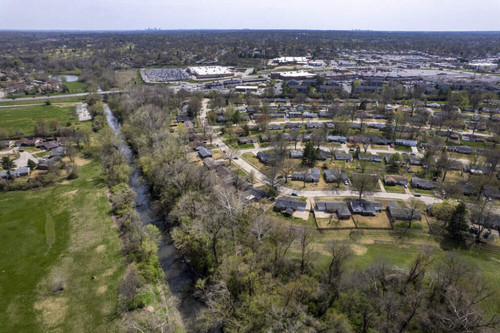The long-term effects of nuclear waste in St. Louis
 Coldwater Creek flows April 7, 2023, in Florissant, Mo. The Army Corps of Engineers has determined that soil is contaminated beneath some suburban St. Louis homes near Coldwater Creek, where nuclear waste was dumped decades ago, but the contamination isn't enough to pose a health risk. (AP Photo/Jeff Roberson, File)
The long-term effects of nuclear waste in St. Louis
Coldwater Creek flows April 7, 2023, in Florissant, Mo. The Army Corps of Engineers has determined that soil is contaminated beneath some suburban St. Louis homes near Coldwater Creek, where nuclear waste was dumped decades ago, but the contamination isn't enough to pose a health risk. (AP Photo/Jeff Roberson, File)
The long-term effects of nuclear waste in St. Louis
wbur.org | Willis Ryder Arnold, Meghna Chakrabarti, Tim Skoog | September 11, 2025
For decades, kids in St. Louis County caught crawdads in Coldwater Creek, made mudpies, went swimming — and
were exposed to nuclear waste.
Today, On Point: How St. Louis became a dumping ground for radioactive waste generated by the Manhattan Project.
Guests
Doug Clemens, current state representative from the 72nd District near Coldwater Creek and the West Lake Landfill.
Linda Morice, Author of
Nuked: The Echoes of the Hiroshima Bomb in St. Louis.
Also Featured
Debbie Mason, cancer survivor and former resident of North St. Louis County.
Cindi Schroeder, former resident of North St. Louis County who lost her son to cancer.
Transcript
Part I
MEGHNA CHAKRABARTI: Debbie Mason had a typical childhood in Florissant, Missouri. A house and a yard she played in with her three sisters. The house was unremarkable and therefore perfect. A single story, red brick affair with white trim and a screened in porch where the family often ate meals. And behind the house there was a creek...
"A lot of this is ... a talcum powder consistency ... some of it's stored in barrels which rusted [and] opened up, but some of it, just piles in open air."
...MASON: My middle sister, Denise, got
breast cancer in 2010. She was stage three. She was 45. Then my youngest sister got
breast cancer in 2017 and she was 48. She didn't have any cancer in her lymph nodes...more
https://www.wbur.org/onpoint/2025/09/11/long-term-effects-nuclear-waste-in-st-louis
This rebroadcast
originally aired on June 2, 2025
Related:
Nuclear waste and contamination reports from the archives | 60 Minutes Full Episodes
51,623 views Sep 13, 2025 60 Minutes
From 2006, Stahl’s visit to the site along the Columbia River in Hanford, WA., where waste left over from the production of nuclear weapons is stored. From 1991, Harry Reasoner’s report on allegations that the federal Government
deliberately put civilian employees at risk by underestimating the health hazards associated with working at its nuclear weapons plants. From 1994, Stahl’s report on how the same giant corporations who were responsible for radioactive waste now have government contracts to clean it up. From 2002, Lesley Stahl’s report on the failure to construct secure vessels and storage facilities for 90 million gallons of liquid nuclear waste -- some of which is leaking - despite having already spent billions on the effort. From 2004, Steve Kroft’s report on the controversy over the U.S. Government’s decision at that time to move massive quantities of radioactive waste from temporary storage facilities to Nevada for permanent burial under Yucca Mountain. From 2014, Bob Simon’s visit to Chernobyl. And also from 2014, Simon’s report on
the aftermath of the Fukushima nuclear disaster.
